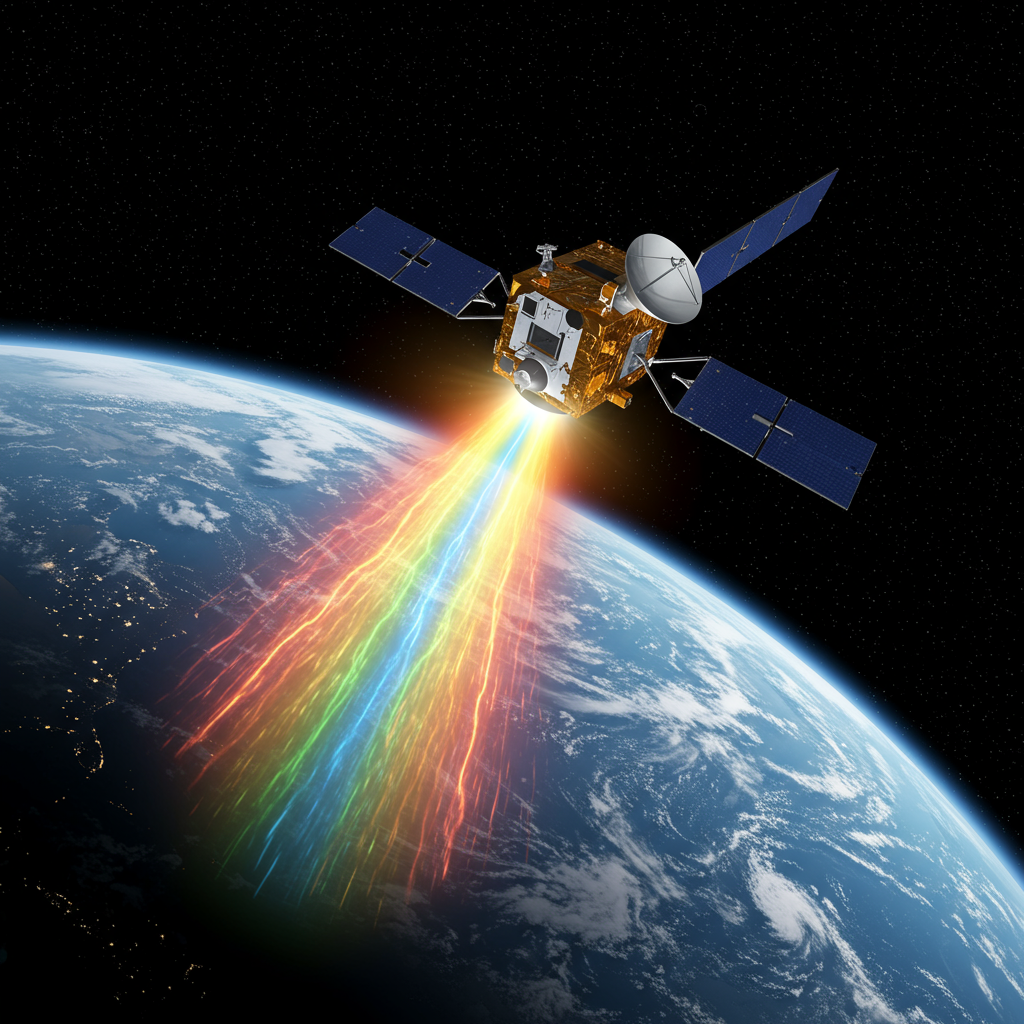space is full of surprises, but few are as baffling as a “dead” piece of space junk suddenly sending out a powerful signal after decades of silence. That’s exactly what astronomers recently observed. NASA’s relay 2 satellite, defunct for nearly 60 years, unexpectedly emitted an intense radio pulse. This mysterious event, detected by a telescope in Australia, has scientists buzzing and offers intriguing insights into the conditions in Earth’s orbit.
This isn’t a scene from a sci-fi movie where an old satellite mysteriously powers back up. Experts believe the signal came from a sudden burst of energy, perhaps an electrical spark, rather than a reactivation of the satellite’s systems. Tracking this brief, powerful flash back to a known piece of space debris highlights new possibilities for understanding our crowded orbital environment and the potential hazards lurking there.
A Mysterious Pulse Detected
The unexpected discovery happened in June 2024. A team of astronomers in Australia was using the Australian Square Kilometre Array Pathfinder (ASKAP) radio telescope. Their primary goal? To search for distant, powerful flashes of electromagnetic radiation known as fast radio bursts (FRBs). These typically originate from far-flung galaxies billions of light-years away.
However, during a routine scan of the southern hemisphere sky, they picked up something unusual. It was a burst of radio waves that was incredibly bright and exceedingly quick. What made it truly perplexing was its origin. Unlike the cosmic signals they usually hunted, this one appeared to be much closer to Earth.
The signal was remarkably intense, briefly outshining objects like entire galaxies in radio wavelengths. Yet, it lasted for an astonishingly short time – less than 30 nanoseconds. The combination of extreme brightness and ultra-short duration immediately captured the astronomers’ attention.
Pinpointing the Source
Following the detection, lead researcher Clancy James and his team at Curtin University began the complex task of tracing the signal’s origin. Using ASKAP’s capabilities, which involve an array of 36 dishes working together, they were able to pinpoint the source location with high precision.
To their surprise, the location matched the known orbital path of a specific object: NASA’s defunct Relay 2 spacecraft. This communications satellite was launched way back in 1964 from Cape Canaveral, Florida. Relay 2 had ceased operations decades ago, becoming just another piece of space junk orbiting Earth. The idea that it could emit such a powerful signal after nearly 60 years of dormancy seemed incredible.
The signal’s proximity was also key. ASKAP’s instruments struggled to focus on it simultaneously across the array, a sign that it was very close. Calculations estimated its origin point to be within 20,000 kilometers (about 12,400 miles) of Earth, much closer than any typical FRB source.
What Was NASA’s Relay 2 Satellite?
Launched as part of NASA’s early efforts in satellite communications, Relay 2 was an experimental spacecraft designed to test the transmission of television, telephone, and telegraph signals across the Atlantic and Pacific oceans. It followed the Relay 1 satellite, which launched in 1962.
Relay 2 was successful during its operational life, facilitating important early satellite communication links. However, its working life was relatively short. Both of its onboard transponders failed by June 1967. This effectively ended its mission, rendering the satellite inoperable. Since then, it has continued to orbit Earth as silent space debris, posing no threat but also serving no purpose.
Given its inactive status since 1967, the detection of a powerful radio pulse originating from its location was profoundly unexpected. The satellite had no active electronics that could generate such a signal on their own.
Explaining the Baffling Radio Pulse
Since the satellite’s internal systems were confirmed to be dead, the radio pulse must have been triggered by something external or a latent internal process unrelated to active function. Astronomers have proposed two main theories to explain this mysterious event.
The leading explanation centers on electrostatic discharge. Satellites orbiting Earth, especially as they pass through regions like the magnetosphere, can build up significant static electricity charges. This is similar to how shuffling your feet on a carpet can build up a charge that discharges as a spark when you touch something. On a satellite, such a charge could build up over years or decades. When the charge becomes large enough, it can suddenly jump from one part of the spacecraft to another, creating a “spark.” This spark is essentially a brief, intense flow of electricity.
According to this theory, the radio pulse was the electromagnetic energy released by this electrostatic discharge. The signal’s extreme brevity (less than 30 nanoseconds) and brightness are consistent with such a powerful, sudden electrical event. Researchers noted this was the first time such a bright and short spark had been directly observed emitting a radio pulse from a satellite.
An Alternative Theory: Micrometeoroid Impact
While electrostatic discharge is the primary hypothesis, scientists haven’t ruled out another possibility: a micrometeoroid impact. Earth’s orbit is filled with tiny particles of space dust and rock. Even a minuscule particle, hitting a satellite at orbital velocities, carries a significant amount of kinetic energy.
Such an impact could vaporize a tiny amount of material from the satellite’s surface and the micrometeoroid itself, creating a brief, superheated cloud of charged gas, or plasma. This plasma is highly energetic and can also emit radio waves.
Distinguishing between a powerful electrostatic discharge and a micrometeoroid impact based solely on the radio signal’s characteristics is challenging, as both could potentially produce similar-looking pulses. However, the observed sharp, well-defined shape of the Relay 2 pulse, combined with its extreme brevity (around 1,000 times shorter than previously recorded electrostatic signals from satellites), led researchers like Clancy James to favor an external trigger like discharge or impact.
Why This Discovery Matters
Beyond the immediate scientific curiosity of a dead satellite emitting a signal, this discovery holds significant implications for both astronomy and space operations.
First, it demonstrates the versatility of advanced astronomical tools like ASKAP. Designed primarily to study distant cosmic phenomena, these telescopes can also provide valuable insights into our much closer orbital environment. They offer a new way to detect and analyze unexpected signals originating from near-Earth objects.
Second, the event highlights potential hazards in Earth’s orbit. Electrostatic discharges on satellites are a known concern. They can cause damage to sensitive electronics or interfere with operations. While Relay 2 was inactive, a similar event on an active satellite could be problematic. This detection serves as a potent reminder of the dynamic and sometimes unpredictable electrical environment in space.
Experts like Karen Aplin note that such surprise detections could pave the way for new diagnostic techniques. Monitoring radio emissions from satellites might become a novel method to detect and evaluate the risk of electrostatic discharges, especially relevant with the increasing number of satellites and accumulated space debris. Understanding these events is crucial for the safety and reliability of our growing satellite infrastructure.
Ultimately, this brief flash from a satellite launched during the dawn of the Space Age underscores the ongoing need to monitor and understand the space environment close to home. It shows how seemingly insignificant pieces of space junk can still hold scientific value and even pose unforeseen questions.
Frequently Asked Questions
What was the strange signal detected from the Relay 2 satellite?
Astronomers detected an unusual, very bright, and incredibly short burst of radio waves originating from the location of the defunct Relay 2 satellite in June 2024. The signal lasted less than 30 nanoseconds but was so intense it momentarily outshone distant galaxies in radio wavelengths. Its strength was measured at over three million janskys, equivalent to roughly 400 watts of power reaching the telescope.
Why did the dead Relay 2 satellite emit a radio signal after so many years?
Relay 2 has been inoperable since 1967. Scientists believe the signal was caused by an external trigger or a latent energy release, not a reactivation. The leading theory is an electrostatic discharge, where static electricity built up on the satellite over time suddenly sparked, releasing electromagnetic energy. An alternative theory is a micrometeoroid impact, where a tiny space rock collision created a brief burst of charged gas emitting radio waves.
How does this discovery impact future space research or satellite operations?
This event is significant because it shows that astronomical tools designed for deep space can also monitor near-Earth objects for unexpected signals. It also highlights the potential hazard of electrostatic discharges in orbit, demonstrating how powerful and brief they can be. Understanding these events could lead to new techniques for monitoring space weather and assessing risks to active satellites, particularly relevant as Earth’s orbit becomes more crowded with spacecraft and debris.
Conclusion
The unexpected radio pulse from NASA’s Relay 2 satellite serves as a fascinating footnote in the history of space exploration. A satellite silent for nearly six decades suddenly speaks, albeit through a mysterious burst of energy. While not a sign of a miraculous return to life, this brief, intense spark offers valuable data. It reminds us that the space environment is dynamic and full of potential phenomena we are still working to understand. This event underscores the importance of continued monitoring of our orbital neighborhood, not just for active satellites but for the legacy of space exploration silently orbiting above us. Future research based on such detections could lead to enhanced safety measures and a deeper understanding of the forces at play in Earth’s orbit.




